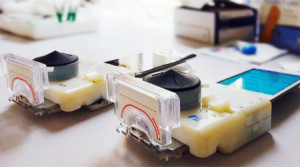This breakthrough in technology miniaturization holds great promise for improving public health, but portends a disruptive future ahead for the medical labs
Is the medical laboratory industry ready for a handheld device that can do immunoassay testing without requiring any stored energy? The secret of this device, already undergoing field trials in Rwanda, is that it uses a smartphone accessory, or “dongle,” to capture and transmit the results of the lab tests.
This innovative smartphone device accurately diagnoses HIV and syphilis with a finger prick of blood and displays the results on the smartphone screen within 15 minutes, according to a Columbia Engineering News Service report.
An Ideal Device for Field Work in Resource Poor Areas
It’s mobile and inexpensive, making it an ideal diagnostic tool for use in poor, remote regions of the world. According to World Health Organization (WHO) statistics, the highest percentages of all sexually transmitted disease (STD) cases occur in developing and underdeveloped nations.

Point-of-care smartphone dongles, like the ones pictured above, were used to screen 96 expectant mothers for HIV and syphilis in Rwanda. The device tests for three infectious diseases simultaneously using just one finger prick of blood and displays the results on a smartphone screen in 15 minutes. (Photo copyright Samiksha Nayak, Columbia Engineering.)
The device was developed by a team of engineers at New York’s Columbia University led by Samuel K. Sia, PhD, Associate Professor of Biomedical Engineering at Columbia Engineering. It’s easy to use and plugs into the headphone jack of a smartphone, tablet or computer.
According to the Columbia Engineering News story, it’s the first smartphone lab test gadget capable of replicating all mechanical, optical, and electronic functions of a lab-based blood test. Specifically, it performs an enzyme-linked immunosorbent assay (ELISA) without requiring any stored energy. It draws all necessary power from the smartphone.
The device is small enough to fit into one hand. It runs assays on a disposable plastic cassette with disease-specific zones that are preloaded with reagents to provide results similar to an ELISA essay, explained Sia. But unlike ELISA equipment, which typically costs $18,450, the dongle could be manufactured for an estimated $34.

Associate Professor Samuel Sia, PhD (above), led the team of biomedical research engineers who developed a smartphone dongle that replicates the capabilities and functions of big medical laboratory analyzers. (Photo copyright Columbia Engineering.)
Device Performs Multiple Tests Simultaneously
What makes this technology truly remarkable is it performs a triplex immunoassay formerly unavailable in a single test format. It tests for:
• HIV antibody;
• Treponemal-specific antibody for syphilis; and,
• non-Treponemal antibody for active syphilis infection.
Rwandan Field Test Confirms Accuracy of Immunoassay Test Device
Healthcare workers in Rwanda recently conducted a pilot study using the device to test its sensitivity and specificity on 96 patients enrolled at prevention-of-mother-to-child-transmission clinics or voluntary counseling and testing centers. Results of the pilot study were published in the February 4, 2015, issue of Science Translational Medicine.
According to the authors of the study, the microfluidic-based diagnostic test for HIV and syphilis is based on the standard immunoassay, but uses gold-labeled antibodies to detect HIV and syphilis antigens in only 2 μl (microliters) of whole blood. It then uses silver reagents to amplify the resulting signal.
“Evaluated side by side with the gold standard tests for HIV and syphilis, the dongle produced results with a sensitivity and specificity needed for making treatment decisions in the field,” wrote the researchers in Science Translational Medicine. They noted that with a few next-generation tweaks, including reducing the size of the dongle, the entire diagnostic package would be ready for adoption by healthcare workers in resource-poor clinics and communities, empowering them to administer timely and appropriate treatment.
Major Breakthrough in Biomedical Technology Miniaturization
Sia’s miniature diagnostic analyzer joins a growing list of medical diagnostic devices developed to deliver test results to smartphone and other mobile devices. It packs the functions and capabilities of big specimen analyzers found in centralized medical laboratories into a tiny, mobile point-of-care device that uses a smartphone app to report results. It also provides caregivers a lower cost, quicker-to-answer test result than is possible at a clinical laboratory.
These types of technological breakthroughs promise great improvement in public health, particularly in isolated communities with limited access to healthcare facilities. But it also signals the coming of diagnostic technology that could eventually find a place in medical laboratories in developed nations.
—Patricia Kirk
Related Information:
Smartphone, Finger Prick, 15 Minutes, Diagnosis—Done!
A Smartphone Dongle for Diagnosis of Infectious Diseases at the Point of Care



